Alstom Coradia LINT
| Coradia LINT | |
|---|---|
 Coradia LINT 41 operated by Arriva, Denmark | |
|
Arriva Denmark LINT 41 interior | |
| Specifications | |
| Train length |
LINT 41: two cars, 41.89 m (137 ft 5 1⁄4 in) |
| Car length | LINT 27: 27.26 m (89 ft 5 1⁄4 in) |
The Alstom Coradia LINT is a single-unit or two-unit articulated railcar manufactured by Alstom, offered in diesel and hydrogen models. The acronym LINT is short for the German "leichter innovativer Nahverkehrstriebwagen" (light innovative local transport rail vehicle). It was designed by Linke-Hofmann-Busch (LHB; acquired 1996 by Alstom) and has been distributed as part of Alstom’s Coradia family.[1]
Description
The type designation gives the vehicle's length: The one-piece type LINT 27 has a length of 27.26 metres (89 ft 5 in) and is also known as Baureihe 640 (DB class 640) of Deutsche Bahn. The two-part train, LINT 41, is 41.89 metres (137 ft 5 in) long. In Germany it is called Baureihe 648 (DB Class 648).
The Alstom Coradia LINT is part of Alstom Coradia family of Inter-city trains which includes multiple unit diesel (DMU) or electric (EMU) as well as double-decker trains. The LINT family offers capacities ranging from 70 to 300 seated passengers. They operate at speeds ranging from 100 to 180 km/h (62 to 112 mph).
The Coradia trains are manufactured in Salzgitter in Germany, Reichshoffen in France and Savigliano in Italy.
The Italian adaptation is called Coradia Minuetto, and the French version, used in France and Luxembourg, is classed as Class X 73500 (A-TER).[2]
LINT 27
The one-piece railcars have 315-kilowatt (422 hp) engines and a maximum speed of 120 km/h (75 mph). The train has 52 2nd class seats, eight 1st class 1 seats and 13 tip-up seats. Up to three cars can run together in multiple unit form.
The trains are predominantly used on non-electrified light railways in North Rhine-Westphalia amongst other regions.
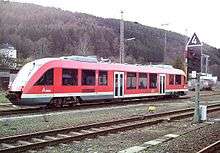 DB LINT 27
DB LINT 27
LINT 41 and LINT 54
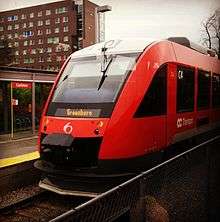 Coradia LINT O-Train in Ottawa, Ontario, Canada
Coradia LINT O-Train in Ottawa, Ontario, Canada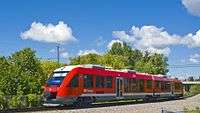
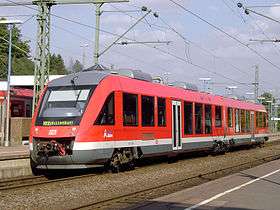 DB LINT 41
DB LINT 41 vlexx LINT 54 at Mainz Hbf
vlexx LINT 54 at Mainz Hbf
Both the LINT 41 and LINT 54 consist of two parts. The longer carriage length of the LINT 54 allows for an extra set of doors per carriage, whilst the LINT 41 has only one set per carriage. Some transportation companies offer ticket machines in the door area. The two-piece railcars have two 315-kilowatt (422 hp) engines.
The trains are mainly used in Northern Germany and North Rhine-Westphalia. They are also quite popular in other European countries. For example, in Denmark they are being used by the largest non-state-owned operator, Arriva (a total of 43 units: 30 delivered in 2004-2005, 11 delivered in 2010–11 and 2 delivered in 2012) as well as by Lokalbanen A/S and Regionstog (a total of 42 units delivered in 2006-2007). In the eastern provinces of the Netherlands, they are operated by Syntus which is now Keolis Nederland.[3]
They are also used in Canada. Alstom delivered six new trains to operate on the O-Train Trillium Line in Ottawa. The new trains went into service on 2 March 2015, displacing the previous Bombardier Talent fleet.[4]
Lint 41 has 115 seats, while the Lint 54 can have between 150 and 180 seats.[5]
LINT 81
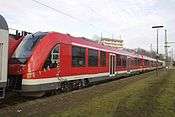 DB LINT 81 prior to entering service
DB LINT 81 prior to entering service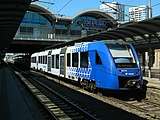 vlexx LINT 81 at Mainz Hbf
vlexx LINT 81 at Mainz Hbf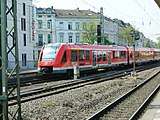 DB LINT 81 at Bonn Hbf
DB LINT 81 at Bonn Hbf
The LINT 81 is a three carriage set, with two driving vehicles with cabs, and an intermediate vehicle for passenger accommodation only.
In September 2012, Netinera ordered 63 Coradia LINT trains from Alstom, which would be used on services in Rheinland-Pfalz. The order included some LINT 54 DMUs (160 seats) and 18 Lint 81 (270 seats).[6]
iLint
The Coradia iLint is a version of the Coradia Lint 54 powered by a hydrogen fuel cell.[7] Announced at InnoTrans 2016, the new model will be the world's first production hydrogen-powered trainset. The Coradia iLint is able to reach 140 kilometres per hour (87 mph) and travel 600–800 kilometres (370–500 mi) on a full tank of hydrogen. It is assembled at Alstom's Salzgitter plant.[7] It began rolling tests at 80km/h in March 2017.[8] In September 2018, the first Coradia iLint entered service on the Buxtehude-Bremervörde-Bremerhaven-Cuxhaven line in Lower Saxony, Germany.[9] A mobile hydrogen filling station refuels these trains, however, a stationary station is set to be built by 2021[10] along with 14 more of these trains.[11]
.jpg) iLint
iLint
Gallery
- Lokalbanen LINT 41 at Snekkersten Station
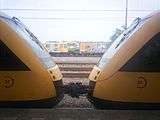 LINTS coupled
LINTS coupled LED lighting
LED lighting- Cabin
See also
References
- ↑ www.de.alstom.com CORADIA LINT Attractive Solutions for your Region - Retrieved on 2010-05-01
- ↑ www.webmag.transport.alstom.com Archived 2008-09-05 at the Wayback Machine. CORADIA LINT: A vehicle with many faces - Retrieved on 2010-05-01
- ↑ https://www.keolis.nl/over-keolis-nederland/wie-zijn-we
- ↑ "Alstom Coradia Lint commuter trains start commercial service in Ottawa". Alstom. 2016-01-15.
- ↑ www.de.alstom.com Archived 2014-04-19 at the Wayback Machine. CORADIA LINT Attractive Solutions for your Region - Retrieved on 2014-04-17
- ↑ "Netinera orders 63 regional trains from Alstom - Railway Gazette". Railway Gazette International. Retrieved 24 September 2012.
- 1 2 "Alstom unveils its zero-emission train Coradia iLint at InnoTrans" (Press release). Alstom. 2016-09-20. Retrieved 2016-09-21.
Coradia iLint is based on the service-proven diesel train Coradia Lint 54. It will be manufactured in Salzgitter, Alstom’s largest site.
- ↑ "Alstom's Coradia iLint completes first 80km/h test". Retrieved 15 March 2017.
- ↑ "Germany rolls out world's first hydrogen train". Phys.org. AFP. September 17, 2018. Retrieved 18 September 2018.
- ↑ "Choo-choo without CO2: World's first hydrogen-powered train enters service in Germany". RT International. Retrieved 2018-09-18.
- ↑ France-Presse, Agence (2018-09-17). "Germany launches world's first hydrogen-powered train". the Guardian. Retrieved 2018-09-18.
Sources
- "Моторвагонные поезда Coradia компании Alstom", Железные дороги мира (in Russian) (11), 2000, archived from the original on 2007-08-16
- D. Klump; N. Klein (1999), "CORADIA LINT : Regionaltriebwagen von ALSTOM", Glasers Annalen (in German), 123 (9): 324–329, ISSN 0941-0589
External links
